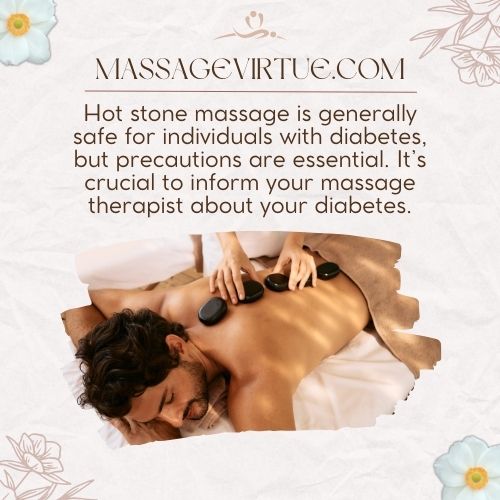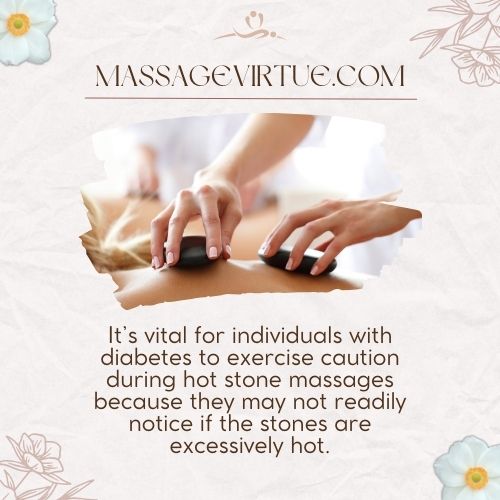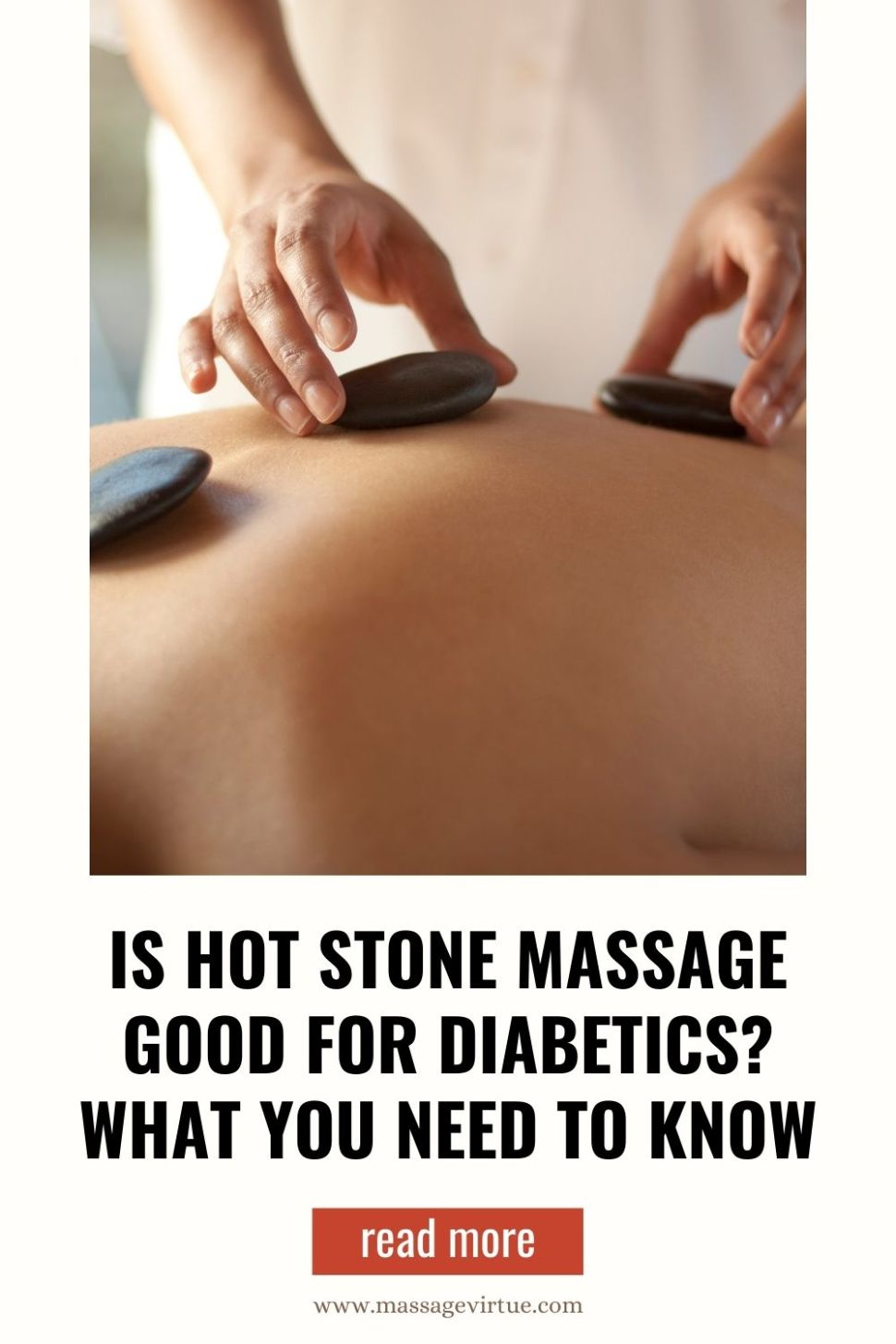Hot stone massage is a popular form of massage therapy that involves the use of heated stones to provide relaxation and pain relief.
People with diabetes often wonder if hot stone massage is safe and beneficial for them, considering the unique challenges associated with the condition.
This article aims to provide information on the potential benefits and risks of hot stone massage for individuals with diabetes.
Is Hot Stone Massage Safe for Diabetics?
Hot stone massage is generally safe for individuals with diabetes, but precautions are essential. It’s crucial to inform your massage therapist about your diabetes, particularly if you have complications like neuropathy.

While hot stone massage can offer benefits, it also carries risks.
To ensure safety, consult your healthcare provider, choose an experienced therapist, and communicate your condition and comfort levels.
Regularly monitor your blood sugar levels, especially before and after the massage, to manage any fluctuations effectively.
Benefits of Hot Stone Massage for Diabetics
If you have diabetes and want to have a hot stone massage, it may provide some amazing benefits. Let’s have a look at some of these benefits:
3. Enhanced Circulation
The hot stone massage is known to promote improved blood circulation, which can be especially advantageous for individuals with diabetes.
Better circulation can reduce the risk of complications related to poor blood flow in the extremities.
2. Relaxation and Stress Relief
Managing diabetes can be stressful, and stress can affect blood sugar levels.
Hot stone massage offers deep relaxation and stress relief, potentially aiding in overall well-being and assisting in blood sugar management.
3. Alleviation of Pain
Diabetic neuropathy, a common diabetes-related complication, can lead to nerve pain and discomfort.
Hot stone massage has the potential to provide relief from some of this pain, offering comfort to those with diabetic neuropathy.
Risks and Considerations for Diabetics
Beyond its benefits, having a hot stone massage during diabetes is somehow risky too. Let’s explore some potential risks hot massage therapy has to offer.
1. Temperature Sensitivity
Diabetics often experience reduced sensitivity to temperature changes.

Individuals with diabetes need to exercise caution during hot stone massages because they may not readily notice if the stones are excessively hot.
Open communication with your massage therapist is crucial to ensuring a comfortable and safe experience.
2. Skin Integrity
Diabetes can impact skin health, making it more susceptible to injury and infections.
Before receiving a hot stone massage, carefully inspect your skin for any cuts, bruises, or open sores.
It’s imperative to inform your therapist of any skin issues to prevent potential complications.
3. Blood Sugar Management
If you’re using medications or insulin to control your blood sugar levels, closely monitor them both before and after a hot stone massage.
The massage may have an impact on your blood sugar, so it’s advisable to have a light meal or snack before the session to avoid the risk of low blood sugar during the massage.
Safety Tips for Hot Stone Massage with Diabetes
| Safety Tips | Description |
| Consult Your Doctor | Before getting a hot stone massage, consult your healthcare provider to ensure it’s safe for your specific diabetes management. |
| Choose a Qualified Therapist | Seek a licensed and experienced massage therapist who understands the special considerations of diabetes. |
| Communication | Inform your therapist about your diabetes, any complications, and your comfort level with the temperature of the stones. |
| Hydrate | Drink water before and after the massage to stay well-hydrated, which is essential for managing diabetes. |
| Monitor Blood Sugar | Keep a close eye on your blood sugar levels to prevent any unexpected drops. |
Conclusion
In a nutshell, hot stone massage can offer benefits to individuals with diabetes, such as improved circulation, relaxation, and pain relief.
However, it’s essential to be aware of the potential risks, including the risk of burns and fluctuations in blood sugar.
By taking proper precautions and working with a qualified therapist, individuals with diabetes can enjoy the therapeutic benefits of hot stone massage safely and comfortably.
FAQs
Can Someone With Diabetes Get a Hot Stone Massage?
Yes, people with diabetes can usually get a hot stone massage, but precautions are needed. Talk to your doctor and inform the therapist about your diabetes and any complications.
What Kind of Massage is Good for Diabetics?
Massages like Swedish or gentle relaxation massages are good options for diabetics. They promote relaxation and improve blood flow.
Who Shouldn’t Get a Hot Stone Massage?
People with certain medical conditions like skin conditions, pregnancy, or sensitivity to heat shouldn’t get a hot stone massage.
Why Would Diabetes Restrict a Massage?
Diabetes can cause reduced sensitivity to heat, which may lead to burns from the hot stones. It’s essential to communicate with the therapist and take necessary precautions.
Who is a Hot Stone Massage Best For?
Hot stone massages are great for those looking to relax, relieve stress, and improve circulation. They can also help with muscle pain.
What Happens to Your Body After a Hot Stone Massage?
After a hot stone massage, you’ll likely feel relaxed and have improved blood flow. It can ease muscle tension and promote a sense of well-being.
Remember to stay hydrated and monitor your blood sugar if you have diabetes.


